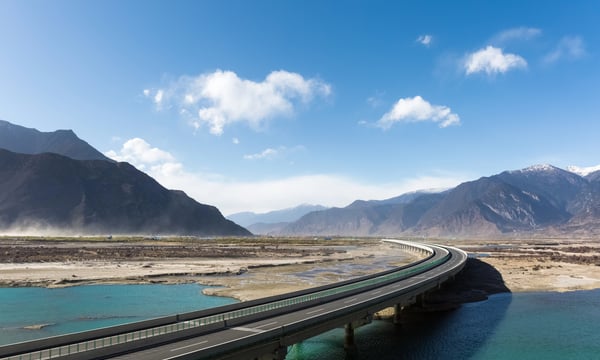Amid the crowded headlines on the South China Sea and Taiwan Strait, another transformation of considerable consequence is unfolding quietly on the roof of the world. The Tibetan Plateau – often known in the scientific literature as the Qinghai-Tibet Plateau and also called the Third Pole – is becoming an increasingly important component of Beijing’s national power architecture. Yet its remaking is not only military or infrastructural. It is also technological and, importantly, environmental.
COP30 in Brazil must discuss how national sovereignty and global ecological interdependence intersect in one of the world’s most fragile ecosystems.
Recent years have seen a steady consolidation of the People’s Liberation Army (PLA) Western Theater Command through a network of dual-use infrastructure across Tibet. Roads, airfields, rail links, and logistics hubs now enable rapid troop mobility along the China-India frontier. These developments are part of what Beijing calls its Military-Civil Fusion (MCF) doctrine.
MCF represents more than an operational doctrine. It is a form of “infrastructural deterrence,” in which mobility, access, and logistics substitute for overt escalation. The same highway that moves civilians one week can carry an infantry division the next. The result is a frontier where development and deterrence are structurally indistinguishable. Of course, such fusion is not exclusive to China, and deterrence is preferable over overt escalation.
Tibet’s militarization and its civilian expansion have therefore become interlinked processes. Four overlapping objectives are powering this transformation: positioning Tibet as an energy and commodities hub for the emerging AI-driven economy; pre-empting India’s northbound strategic depth; securing some degree of leverage over South Asia’s hydrology; and reinforcing sovereignty over the plateau. Each of these objectives contributes to what can be seen as comprehensive frontier consolidation.
The Hydro-Strategic Layer
Tibet’s significance rests not only in its elevation but in its endowments. The plateau is the source of more than 10 major river systems – including the Brahmaputra, Mekong, and Salween – which sustain some 2 billion people downstream. As climate change accelerates glacial melt and alters monsoon patterns, the control of these headwaters becomes an issue of both national resilience and regional interdependence.
Beijing’s vast hydropower program – including the recently announced mega-project on the lower reaches of the Yarlung Tsangpo River – reflects as much a bid for hydro-sovereignty as for energy production. It aligns with China’s broader objective to secure as much autonomy across all domains as possible.
According to estimates, Tibet’s rivers hold more than a third of China’s hydroelectric potential. The latent generation capacity exceeds 200 GW: enough to power a large European country for about a year. This renewable base could become essential as China grapples with the energy demands of artificial intelligence and data infrastructure, sectors that are consuming an increasing share of national electricity and water. In that sense, the plateau can be recast as a clean-energy hinterland underpinning China’s technological ascent.
The Environmental Angle
Yet these gains come with complex environmental trade-offs that are not fully aligned with the Paris Agreement and the anticipated push for stronger implementation at the upcoming COP30 in Belem, Brazil. The Belem conference is expected to speed up the Global Stocktake process and deepen commitments to adaptation and loss-and-damage financing. Tibet’s cryosphere – holding the largest reserve of frozen freshwater outside the poles – and should feature in that conversation.
However, China’s national climate submissions under the UNFCCC seldom disaggregate the Tibetan Plateau as a specific ecological zone. Recognizing the plateau’s vulnerability within the UNFCCC reporting architecture could help integrate mountain ecosystems and water-security linkages into the global adaptation agenda. This would also complement the Brazilian presidency’s proposed focus on “climate justice for vulnerable ecosystems.”
Approximately 75 percent of the Tibetan Plateau is now classified as moderately to severely ecologically vulnerable. The permafrost layer – covering 40 percent of the region – is thawing rapidly, destabilizing both ecosystems and infrastructure foundations. This vulnerability is likely exacerbated by human production, consumption, and activity in developed economies, including coastal China, rather than by activities in Tibet itself, but every little bit of local constraint helps. Road construction and high-altitude infrastructure projects on the plateau are increasingly linked in academic literature to elevated ecological risk and heavy-metal soil contamination, though precise data tying contamination to military training zones remains limited.
This tension between development and degradation raises difficult questions for global climate governance. China’s decarbonization ambitions and its emphasis on renewables are formally aligned with the UNFCCC framework and the Paris Agreement. While Beijing positions itself as a leader in climate cooperation and clean-energy deployment – and it has made great strides toward those ends – it remains constrained by domestic growth imperatives, continued reliance on coal, and its role as the world’s primary factory.
Similarly, Tibet also exemplifies the dual logic of climate policy under strategic conditions: a drive to lead in clean energy while accepting localized ecological cost and ramifications for downstream dependents. There is no policy without trade-offs. China’s policies may sow discontent in the region, and it is better to address this now than down the road, when sentiments have deeper roots.
A Regional and Global Concern
Indeed, the consequences are not confined to China’s borders. Hydrological modeling suggests that by 2035, altered flow regimes from the plateau could affect the water security of hundreds of millions of people downstream. Variations in glacial melt and precipitation could undermine irrigation systems, dam safety, and flood control from the Indus Basin to the Mekong Delta. What occurs in Tibet, in short, will shape the environmental and developmental trajectory of South and Southeast Asia alike.
This is why the plateau’s transformation belongs as much in U.N. climate forums as in regional security dialogues. The UNFCCC’s call for transboundary cooperation on adaptation and early-warning systems provides a potential framework, yet China has been hesitant to translate it into practical mechanisms with downstream countries. Environmental data-sharing remains partial, and basin-wide coordination through bodies such as the Mekong River Commission or the Brahmaputra Dialogue remains limited.
At COP30, delegates will debate the operationalization of early-warning systems and transboundary data cooperation – precisely the mechanisms missing in the Himalayan-Tibetan context. Belem thus provides an unprecedented opportunity for countries dependent on Tibetan rivers, including India, Bangladesh, Myanmar, and those in mainland Southeast Asia, to push for a global “mountain-water framework” under the UNFCCC. Such an initiative would embed Tibet in the broader Global South narrative of equitable adaptation and could encourage China to reframe its climate diplomacy with its neighbors through cooperative rather than competitive lenses.
Such a constructive approach would view Tibet, and the Himalayas for that matter, as a shared climatic asset. The Third Pole’s cryosphere regulates the hydrology of about a quarter of humanity. Recognizing this within global climate processes would not diminish Chinese sovereignty; it would elevate ecological interdependence to the level of policy. Indeed, climate diplomacy could then serve as a stabilizing and trust-building channel between Beijing and its neighbors at a time when some traditional confidence-building measures are faltering. Ultimately, China’s neighbors would appreciate this gesture, and it may help lessen growing tensions among worried elites and civil societies.
Between Ambition and Fragility
None of these measures would necessarily diminish China’s legitimate development imperatives. Tibet’s connectivity projects have brought infrastructure, employment and energy access to regions historically isolated and under-invested. Nor is the environmental degradation solely the result of militarization – industrial activity across Asia contributes far more to carbon loading than military footprints at high altitude.
Still, the plateau is entering a period of heightened fragility. Recent studies show parts of the Tibetan Plateau are warming at about 0.35-0.55 degrees Celsius per decade, roughly two to nearly three times the global average rate. Melting glaciers and permafrost could soon undermine the very infrastructure designed to secure the frontier. The paradox is stark: the tools of territorial consolidation may, in the long run, erode the ground – literally – on which they stand.
What emerges from Tibet, then, is a narrative strategic-ecological entanglement. The region encapsulates how power, technology, and climate policy now converge. Roads and runways coexist with solar farms and hydro grids; deterrence logic intertwines with the energy transition. Tibet is thus becoming both a barometer of China’s modernization and a test-case for whether national security and global sustainability can coexist on the same terrain. This is a theme worth discussing at COP30.
As the UNFCCC convenes in Belem, the Tibetan Plateau stands as a moral and scientific reminder that no global climate regime can claim legitimacy without addressing the Himalayan-Tibetan system. Whether COP30 acknowledges this frontier as a cornerstone of climate stability will determine not just the success of one conference, but the credibility of mutual climate governance itself.
In the coming decade, the plateau will influence three debates simultaneously: Asia’s strategic balance, the geopolitics of water, and the credibility of the global climate regime. Its fate will tell us whether great powers can integrate ecological stewardship into their pursuit of resilience – or whether climate governance will remain secondary to geopolitics.
As Washington prioritizes geopolitical competition over climate governance, Beijing has an opportunity to demonstrate an alternative path, in line with its new Global Governance Initiative. Besides, the other permanent members of the United Nations Security Council (UNSC), including the United Kingdom, which has played a decisive role in the region historically, must shoulder particular responsibility. As custodians of global stability and the Paris framework’s founding advocates, they should treat the Tibetan Plateau as a common climate concern, not a peripheral issue. No matter how ambitious it may appear, a joint statement or cooperative initiative from the P5 at COP30 – linking climate security with ecological peace – would send a vital message that strategic competition need not eclipse collective survival.






